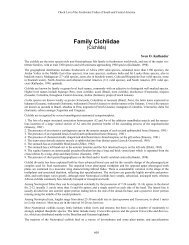Open Access PDF - Sven Kullander
Open Access PDF - Sven Kullander
Open Access PDF - Sven Kullander
Create successful ePaper yourself
Turn your PDF publications into a flip-book with our unique Google optimized e-Paper software.
specimens, the lower rays of the caudal fin commonly<br />
appear regenerated, with irregular scale<br />
cover, but we cannot directly relate such anomalies<br />
to fin predation.<br />
Species phylogeny. The present paper makes<br />
use principally of external characters with the<br />
objective of formal description of diagnosable<br />
species. Diagnostic characters ideally are species<br />
autapomorphies, and the total number of characters<br />
available for hierarchical clustering methods<br />
remains limited; nevertheless the characters<br />
used should contain phylogenetic information.<br />
As detailed above, variability in morphometric<br />
characters (body proportions) is limited, with<br />
considerable overlap between species, and meristic<br />
variation is either very limited, irreconcilable<br />
between species, or highly variable. Colour pattern<br />
is most useful for constructing a character<br />
state matrix (Table 27), although some characters<br />
could not be assessed with confidence in all species<br />
(e.g., juvenile colour pattern). We offer the<br />
following analysis as a platform for discussion<br />
rather than as a strong hypothesis about a historical<br />
scheme of diversification.<br />
Polarisation of character states is problematic<br />
because at the basal level at which Cichla resides<br />
in the cichlid phylogeny, characters used here are<br />
difficult to correlate with those of other cichlids.<br />
The outgroup applied for rooting represents<br />
Retroculus, which is the basal Neotropical cichlid<br />
taxon in <strong>Kullander</strong>’s (1998) analysis, and Crenicichla,<br />
which is the sister group of Cichla in morphological<br />
phylogenetic analyses (Stiassny, 1987;<br />
<strong>Kullander</strong>, 1998) though not in molecular analyses<br />
(López-Fernández et al., 2005). For Creni cichla<br />
information was sampled from the Crenicichla<br />
saxatilis species group, which is morphologically<br />
most similar to cichlids in general.<br />
The outgroup is coded to have bars 1a and 2a<br />
because they have more than three vertical markings,<br />
as discussed above. The abbreviated juvenile<br />
lateral band in Cichla is unique among cichlids<br />
and probably a wider group of fishes, whereas a<br />
complete band is present from Crenicichla. The<br />
occipital bar and potential homologue in other<br />
cichlids is moderately pigmented or absent in<br />
other cichlids. Postorbital markings of some kind<br />
are commonly present in cichlids, like in Crenicichla,<br />
but absent in Retroculus. No other cichlids<br />
have regular light spots along the side, and very<br />
few have any light spots on the side at all. The<br />
lateral line is discontinuous in almost all cichlids,<br />
Ichthyol. Explor. Freshwaters, Vol. 17, No. 4<br />
391<br />
except some Cichla and some extremely terete<br />
other cichlids (Teleogramma, Teleocichla). Ocellated<br />
midline blotches are unique to some Cichla among<br />
cichlids (cf. above). Small species of cichlids generally<br />
have a low pectoral fin count, but large<br />
species usually have more than 14, e.g., 15-18 in<br />
Crenicichla, 15 in Geophagus and Astronotus, 16 in<br />
Retroculus. Total vertebral counts in cichlids are<br />
generally lower than 30; in the outgroup they<br />
vary between 32 and 34 in Retroculus and about<br />
33-35 in C. lepidota and similar species. Ocellated<br />
vertical bars as in some species (C. jariina, C. thyrorus,<br />
C. vazzoleri, C. pinima) are unique to those<br />
taxa. Other cichlids except Crenicichla generally<br />
have much less than 67 E1 row scales, see above<br />
for discussion on possible subdivision into character<br />
states within Cichla. E1 scale counts vary<br />
between 34 and 40 in Retroculus, and generally<br />
between 35 and 60 in C. saxatilis group species.<br />
Parsimony analysis using the branch-and-<br />
Table 27. Character state matrix for species of Cichla.<br />
Retroculus and the Crenicichla saxatilis species group<br />
included as outgroup. Characters: 1, a bars, 0 = present,<br />
1 = absent; 2, juvenile band, 0 = absent, 1 = complete,<br />
2 = abbreviated; 3, occipital bar, 0 = absent or faint,<br />
1 = emphasized; 4, postorbital marks, 0 = present, 1 = absent;<br />
5, light spots along side, 0 = absent, 1 = present,<br />
irregular, not persistent, 2 = regular rows; 6, lateral line,<br />
0 = usually or always discontinuous, 1 = usually or always<br />
continuous; 7, ocellated midline blotches, 0 = absent,<br />
1 = present; 8, modal pectoral fin rays, 0 = 15 (or<br />
more in outgroup), 1 = 14; 9, modal total vertebrae,<br />
0 = 34, 1 = 35, 2 = 36; 10, ocellated vertical bars, 0 = absent,<br />
1 = present; 11, principal variation in E1 scales, 0 = 30-60,<br />
1 = 67-80, 2 = 81-88, 3 = 89-110, 4 = 111-128.<br />
1 2 3 4 5 6 7 8 9 10 11<br />
Retroculus 0 0 0 0 0 0 0 0 0 0 0<br />
Crenicichla 0 1 0 1 0 0 0 0 {0/1} 0 0<br />
C. ocellaris 0 2 0 0 1 1 0 0 2 0 1<br />
C. orinocensis 1 2 0 1 1 0 1 0 2 0 {1/2}<br />
C. nigromaculata 0 ? 0 0 ? 0 0 0 2 0 {1/2}<br />
C. monoculus 1 2 1 0 1 0 0 0 2 0 1<br />
C. kelberi 1 2 1 0 1 0 0 0 2 0 1<br />
C. pleiozona 1 2 1 0 1 0 0 0 2 0 {2/3}<br />
C. mirianae 1 1 0 1 1 0 1 0 1 0 1<br />
C. melaniae 0 1 0 1 1 0 0 0 1 0 2<br />
C. piquiti 0 1 0 1 0 0 0 0 1 0 3<br />
C. thyrorus 1 1 0 1 2 1 0 0 1 1 3<br />
C. jariina 1 1 0 1 2 {0/1} 0 1 0 1 3<br />
C. pinima 1 1 0 1 2 0 0 1 1 1 3<br />
C. vazzoleri 1 1 0 1 2 0 0 {0/1} 1 1 3<br />
C. temensis 1 1 0 1 2 0 0 1 1 1 4<br />
C. intermedia 0 1 0 1 0 1 1 1 2 0 3




